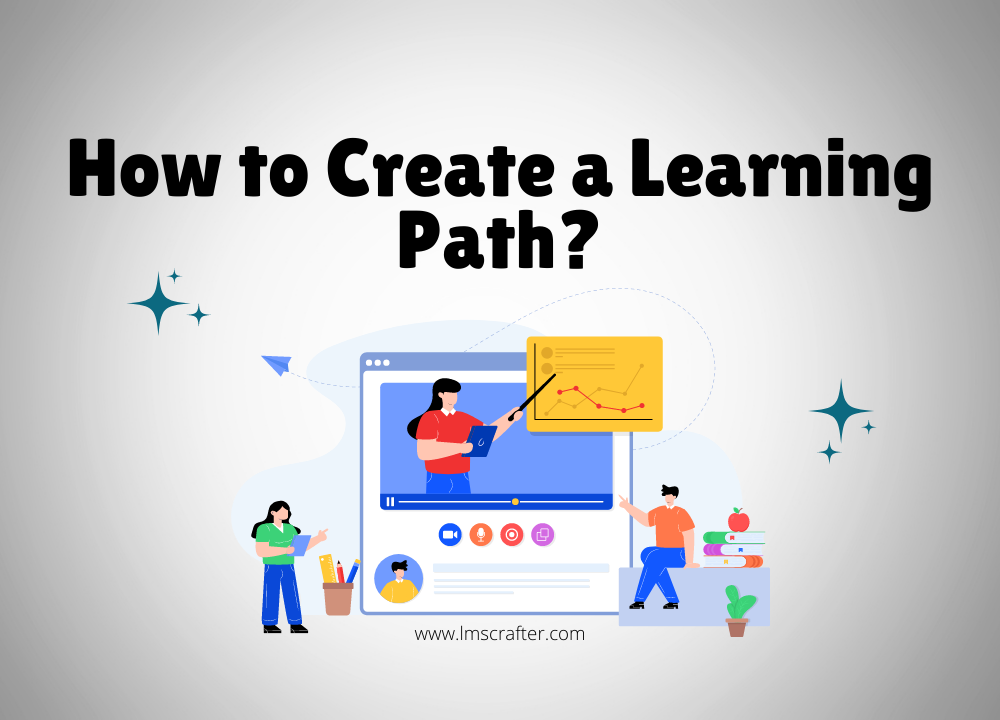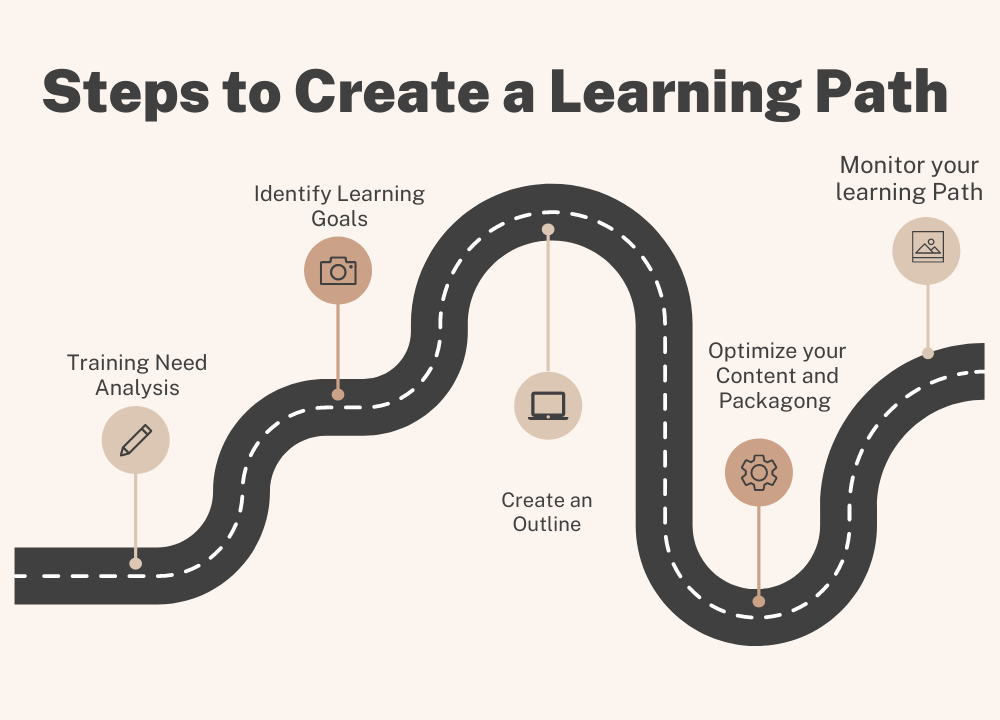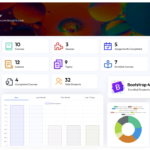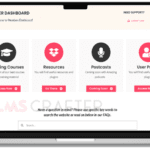
The learning path for LMS assists the students by taking them through a clear route from point A to B. It is a tool that helps to divide the whole course into smaller, manageable chunks and gives a clear route to the students in their course learning journey.
Table of Contents
Toggle- What is a Learning Path?
- Learning Pathway Types:
- Example of Learning Path for LMS:
- Benefits of Learning Paths for LMS:
- Design your Own Learning Path for LMS:
- 1. Conduct a Training Need Analysis:
- 2. Identify Learning Goals:
- 3. Create an Outline
- 4. Optimize your Content and Packaging
- 5. Monitor your Learning Path
What is a Learning Path?
Some courses are not meant to be on an island. They are joined together in a holistic way to teach a comprehensive skill or topic. A learning path for LMS is a selection of courses that are bound together to teach a comprehensive subject.
Students want a practical outcome at the end of a course. Educators can not dump all the information at once, making the whole course or a set of courses more confusing. Rather, they divide the whole plethora of teaching material into small digestible chunks and take the students step by step from the beginning to the final desired results.
This whole concept is called a learning path as it drives students through a clear path along the learning journey so that they do not get muddled.
Learning Pathway Types:
-
Learning Pathway for Employees
Whether it’s employee onboarding or upskilling, training is a must for maintaining the skill level of employees. Generally, you have to enroll the employees in each course one by one. With learning paths, it becomes a lot easier as they streamline employee training.
As all the courses are joined together, you just have to enroll the trainees once and then they are automatically enrolled in all the courses. With the ability of drip-feeding content, they are moved from one course to another until they have reached the finish line.
In a global survey conducted by Capgemini, 70 percent of employees declared that they would like to have access to their learning platforms to learn at their own pace and decide which skills they want to learn.
A learning path is an efficient tool for providing flexibility to employee learning.. You can provide multiple course options for your learners and set a limit on how many courses are necessary to take. Now, it’s up to the learner to choose from the provided courses what suits them best.
Companies integrate their LMS system with the HR system so, whenever a new hire joins, he is automatically enrolled in the LMS system and gets along the learning path to finish their training.
-
Learning Pathway for Partners and Customers
Learning paths are also used for partner education by providing the necessary information about products, and product training, and gaining feedback from them. Learning path simplifies partner education by providing the necessary materials to learn about brands, products, and necessary knowledge to sell your products.
Just like partners, you can also take customers on structured learning by creating learning paths for them. Customers are on-boarded on learning paths to get information about the product, make an informed decision to purchase it, and get the maximum value out of it.
You can walk the leads down the sales funnel by providing common sales queries, explaining product features, informing about any upsells, and building brand loyalty.
-
Learning Pathway for Online Courses
When you are building an online course, you are an expert in your field. You have plenty of information to provide and want your students to learn a specific concept or skill but how are you going to deliver all the concepts and knowledge to your non-expert students?
The learning path will help you divide the information in a structured way to gradually take the students being non-expert to a full specialist position. These smaller steps help the students to digest all the information without being blurred and increase their chances of success.
Example of Learning Path for LMS:
Let’s say you are a chef and build a course on cooking.
First, examine your target audience and see what are their learning goals and what are their current skills. Then examine what are the necessary skills to achieve their desired outcome.
Then you will find their skill gap and you will know what do they want from your course?
Now think of yourself as a knowledge base and what you want to deliver to your students which is your course topics. Here, your whole course is “How to become a professional chef?”
Now list down your learning outcomes in which you want your students to be an expert at the end of the course. For example, you want your students to learn 15 recipes which include peeling vegetables, roasting chicken, toasting tortillas etc.
Now split your knowledge into smaller topics like peeling, cutting, toasting, roasting, frying, baking and decorating.
You will have to divide the whole course into smaller topics going from basic skills like peeling and cutting to more specialist skills like decorating and finishing the recipe. Now identify the necessary skills to complete each topic. For example, for cutting you will have to provide necessary information about cutting knives and cutting techniques, etc.
Then define the methods through which you will be providing these necessary skills like written guides, video tutorials etc. This will be the core content of your course which will be comprised of lessons and chapters.
As you can see, by creating a learning path for LMS, you can disseminate your knowledge in a more structured and comprehensive way rather than bombarding all the information all at once.
Benefits of Learning Paths for LMS:
-
A More Structured Program
As we have seen, learning paths provide a structured learning experience to the students. They learn basic things and then move on to more complicated processes. You can control the order in which lessons/courses will be made available as well as the time frame.
You can set a time period after which the next course will be displayed or you can set the option of displaying the next course after finishing the first one.
-
Saves a Lot of Time
By creating a learning path for LMS you save a lot of admin time by automating the whole process. Rather than manually enrolling students in courses one by one, students automatically move from one course to another after meeting certain requirements.
Once all the students are on-board, the whole process becomes wholly self-sufficient. Students can easily move from starting point to the finishing point without much need for work from the admin.
-
Provides Clear Goal with Milestones
Learning pathways ensure that all learners are working towards a common goal. Learners know what is their desired goal and how they are moving towards it step by step through each lesson.
Students have a clear goal with milestones to pass in order to achieve that goal. They know they have to finish the course on their dashboard to go to the next course. You can increase their engagement by adding quizzes, certifications, badges and other gamification tools which makes the whole learning process more fun.
Design your Own Learning Path for LMS:

With these easy steps, you will be able to design your own learning path.
1. Conduct a Training Need Analysis:
In the first step of creating a learning path for LMS, you need to identify the learning goals of your trainees or students. Learn about their current skills level and what skill gaps are hindering them to achieve their desired goals.
Once, you have identified their skill gaps you can tell how your course will help them in learning those specific skills. What will be included in your course to help them achieve their learning goal. So, the first step will include,
- Identifying the target audience.
- Identify their learning goals.
- Measure their skill gaps (the difference between current skill and desired skill).
- Analyze what your audience wants at the end of the course.
- List down what your course will have to include to teach them the necessary skills.
2. Identify Learning Goals:
Once you have done the first step, you have all the information to build on your training course. You know the skills gap of your audience, their desired learning outcomes, and the necessary knowledge and capabilities to reach that goal.
Take all the information and turn it into your learning goal. In our example a cooking course, our learning goal was to teach the students 15 recipes and the necessary skills to make those recipes. It makes the learning process measurable and more achievable.
3. Create an Outline
As you have now analyzed the learning goals as well as necessary skills which need to be taught to your audience to achieve those goals, it’s time to map out how you will be teaching them all these skills.
When you are building a learning path for LMS, a storyboard also helps to manage all the information as you can write down all the points in a more comprehensive way. To read more about storyboards, read here. You need to ask following questions at this step,
What type of content you will include?
What are the instructional tools you will be using?
How you will divide the whole information into smaller modules?
How will these modules be interlinked?
What should be the order and timing of each module and lesson?
Once you have sorted out all the key points, now you just have to build the course on these points by adding content.
4. Optimize your Content and Packaging
Refer back to your learning objectives and analyze that your content optimally meets them. Make sure your learning path is not overloaded with the data.
To build a learning path for LMS, divide the whole content into smaller, achievable milestones and steps. Take your students through these steps in a way that they do not feel like they have missed something in between or they have been overwhelmed with the information.
The whole system should be so comprehensive that each new lesson is built upon the learning outcomes of the previous steps. In this way, there will be a logical progression throughout the learning journey.
5. Monitor your Learning Path
When you have implemented the designed learning path for LMS, it will need constant improvement. If there is something which is not working, analyze the learning path and look for any deficiencies.
Take feedback from your learners about their learning paths and implement any improvements. Make sure your learning path adapts to the requirements of the learners and makes their learning smoother.
Want more resources to build your courses effectively? Check our blogs here for more information on course creation, how to price your next online course, and much more.







